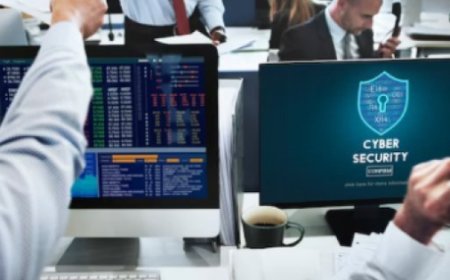The rise of cyber security threats has been fueled by the rapid growth of technology and the internet. With more and more devices being connected to the internet, the potential for cyber-attacks has increased exponentially. This has led to a growing concern among individuals, businesses, and governments about the security of their online data and information. Cyber security threats come in many forms, including malware, phishing attacks, ransomware, and denial-of-service attacks. These attacks can cause significant damage to businesses and individuals, including financial losses, reputational damage, and even legal consequences.
To defend against these threats, there has been a growing investment in cyber security measures, including the development of new technologies and the implementation of best practices for online security. This includes the use of firewalls, antivirus software, encryption, and multi-factor authentication
There is a growing need for collaboration between governments, businesses, and individuals to address cyber security threats on a global scale. This includes sharing information and resources to develop effective strategies for preventing and responding to cyber-attacks. The current state of cyber security is a complex and rapidly evolving landscape that requires ongoing attention and investment. By working together and staying vigilant, we can help to ensure the safety and privacy of online users and protect against the growing threat of cyber attacks.
Cybersecurity is a complex and intricate field that deals with the protection of computer systems, networks, and data from unauthorized access, theft, and damage. It involves a wide range of measures and practices aimed at safeguarding digital information and ensuring the confidentiality, integrity, and availability of critical data. With the ever-evolving nature of technology and the increasing sophistication of cyber threats, cybersecurity professionals face the challenge of staying one step ahead of malicious actors and constantly adapting their strategies to mitigate risks. From implementing robust firewalls and encryption protocols to conducting regular vulnerability assessments and educating users about best practices, the world of cybersecurity is a constant battle to defend against cyberattacks and protect sensitive information.
Amidst these complexities, how can individuals and organizations effectively protect themselves against the diverse array of cyber threats? What are the essential strategies and best practices to mitigate risks and safeguard sensitive information?
Strategies to Safeguard Against Growing Threats
Recognizing Threat Situations:
The Situations of cyber threats are incredibly diverse and variable. It includes a wide set of potential risks, including malware, ransomware, phishing, zero-day exploits, insider threats, and more. To stay ahead of these threats, individuals and organizations must actively monitor and analyze the threat landscape. This involves not only understanding the current threat actors and their tactics but also forecasting potential future threats. Utilizing threat intelligence platforms and engaging with cybersecurity communities can provide valuable insights into emerging vulnerabilities and attack patterns.
Implementing Strong Authentication:
Multi-factor authentication (MFA) is a powerful tool. It adds a layer of security beyond just passwords, making it significantly harder for unauthorized users to gain access. MFA methods can include biometrics (fingerprint or facial recognition), hardware tokens, SMS-based codes, or authenticator apps. Encouraging users to enable MFA across all their accounts, especially those holding sensitive information, drastically reduces the risk of unauthorized access, even if passwords are compromised.
Creating and enforcing password policies is equally crucial. Implementing strong, unique passwords for every account, combined with periodic password changes, further mitigates the risk of successful brute-force attacks or password-spraying techniques used by attackers.
Regular Software Updates and Patch Management:
Software vulnerabilities present a constant risk. Attackers actively seek out and exploit these vulnerabilities to gain unauthorized access or disrupt systems. Timely software updates and patch management are critical to closing these security gaps. This involves regularly applying patches released by software vendors to fix known vulnerabilities. Delayed patching can leave systems open to exploitation, as attackers actively target unpatched vulnerabilities. Automated patch management systems can streamline this process, ensuring that all systems and applications are up to date with the latest security patches.
Employee Training and Awareness Programs:
Human error remains a significant contributor to successful cyber attacks. Cybersecurity awareness training programs should be comprehensive, engaging, and ongoing. Employees need to understand the various tactics employed by cybercriminals, such as phishing emails, social engineering, and fraudulent websites. They should also be educated on how to recognize suspicious activities and report potential security incidents promptly. Regular simulated phishing exercises can be beneficial, providing hands-on experience and reinforcing good security practices.
Utilizing Encryption and Data Protection Measures:
Encryption plays a vital role in safeguarding sensitive data. It ensures that even if data is intercepted during transmission or if unauthorized access occurs, the information remains unreadable and unusable. Implementing robust encryption protocols across all communication channels, storage devices, databases, and cloud services adds an essential layer of protection. Additionally, employing access controls and encryption key management practices further enhances data security by limiting access to authorized personnel and ensuring the integrity of encryption keys.
Implementing a Defense-in-Depth Strategy:
A defense-in-depth strategy involves deploying multiple layers of security controls across various levels of an organization's infrastructure. This approach aims to create redundancy and diversity in defense mechanisms, making it more difficult for attackers to penetrate the entire system. It includes:
-
Firewalls: Protecting networks by filtering incoming and outgoing traffic based on predefined security rules.
-
Intrusion Detection and Prevention Systems (IDPS): Monitoring network or system activities for malicious activities or policy violations.
-
Endpoint Protection: Securing individual devices (endpoints) such as computers, smartphones, and tablets from cyber threats.
-
Network Segmentation: Dividing networks into smaller segments to limit the spread of an attack and reduce the attack surface.
-
Regular Security Audits: Conducting thorough assessments of security controls, policies, and configurations to identify and rectify vulnerabilities.
-
Incident Response Plans: Having predefined procedures to respond effectively to security incidents, minimizing their impact and facilitating recovery.
In present-day society, where technology has become a necessary component of our lives, the increasing cybersecurity risks are a major concern. With the interconnectivity of devices, the abundance of sensitive data, and the constant evolution of advanced cyber threats, it is now more important than ever to have strong cybersecurity measures in place. The need to implement effective strategies for protection cannot be focused enough. Cybersecurity risks encompass a wide range of potential dangers, including identity theft, financial fraud, and even the compromise of critical infrastructure. These risks not only jeopardize individual privacy and financial security but also pose a significant threat to businesses, government organizations, and society as a whole. It is crucial to prioritize robust cybersecurity measures to safeguard ourselves and our digital assets.
Protecting Sensitive Data
Personal Protection:
Awareness and Education: Empowering individuals with knowledge about cybersecurity threats, including phishing scams, social engineering, and identity theft, is crucial. Teaching the importance of strong, unique passwords and the use of two-factor authentication adds layers of security.
Vigilance against Phishing: Educating individuals on how to spot and avoid phishing emails, texts, or calls that attempt to trick them into revealing sensitive information helps in thwarting cyber attacks.
Privacy Settings and Data Encryption: Encouraging the use of privacy settings on social media platforms and utilizing encryption tools for sensitive communications ensures personal data remains secure.
Organizational Measures
Encryption and Access Controls: Implementing robust encryption methods for data storage and transmission coupled with strict access controls ensures that only authorized personnel can access sensitive information.
Regular Data Backups: Creating and maintaining regular backups of critical data helps in quickly restoring information in case of a breach or data loss event.
Employee Training and Security Policies: Regular training sessions for employees on cybersecurity best practices and establishing clear security policies help foster a security-conscious culture within the organization.
Preserving Business Continuity
Resilience Planning:
Incident Response Plans: Developing well-defined incident response plans that outline steps to be taken in case of a cyber attack helps minimize the impact and reduce downtime.
Regular Testing and Drills: Conducting regular simulations and drills to test the incident response plans ensures preparedness and identifies areas for improvement.
Redundancy and Recovery Strategies: Establishing redundant systems and recovery strategies helps in maintaining operations even during cyber incidents.
Supply Chain Security:
Vendor Due Diligence: Implementing stringent security standards and conducting thorough security assessments of vendors and partners reduces the risk of supply chain vulnerabilities.
Contractual Obligations: Ensuring that contracts with suppliers and partners include clauses related to cybersecurity requirements and compliance helps in maintaining a secure supply chain.
Maintaining Trust and Confidence
Transparent Communication:
Data Breach Notifications: Promptly informing affected individuals about data breaches and sharing details about the incident, impact, and steps taken to mitigate the issue helps maintain transparency and trust.
Security Assurance Measures: Sharing information about the security measures in place, such as encryption protocols or regular security audits, reassures customers about the safety of their data.
Compliance and Regulations:
Adherence to Standards: Ensuring compliance with relevant regulations like GDPR, HIPAA, or other industry-specific standards not only avoids legal consequences but also demonstrates a commitment to data privacy and security.
Regular Audits and Assessments: Conducting periodic audits and assessments to ensure compliance with regulations and security standards helps in identifying and rectifying potential vulnerabilities.
Defending National Security
Critical Infrastructure Protection:
Public-Private Partnerships: Collaboration between government entities and private sector organizations is crucial to fortify critical infrastructure against cyber threats.
Continuous Monitoring and Defense: Implementing advanced monitoring systems and robust defense mechanisms to protect essential services like power grids, transportation, and communication networks is imperative.
Cyber Warfare Preparedness:
Investment in Cyber Defense: Allocating resources for cybersecurity capabilities, including threat intelligence, advanced defense systems, and skilled cybersecurity personnel, is essential for national defense against cyber attacks.
Response Teams and Protocols: Establishing dedicated response teams and protocols for addressing cyber threats at a national level helps mitigate the impact of potential attacks.
Mitigating Financial Losses
Cyber Insurance:
-
Risk Assessment and Coverage: Conducting risk assessments and investing in cyber insurance coverage tailored to the organization's specific needs helps in mitigating financial losses resulting from cyber incidents.
Budget Allocation:
-
Risk-Based Approach: Adopting a risk-based approach to cybersecurity budget allocation ensures that resources are directed towards areas with the highest potential impact and vulnerability.
Adapting to Evolving Threats
Continuous Education and Training:
-
Regular Training Programs: Conducting frequent training programs and workshops to educate employees about new cyber threats, attack methods, and security best practices helps in building a proactive defense.
-
Simulations and Drills: Organizing simulated cyber attack scenarios to test the readiness of employees and refine incident response plans improves preparedness.
Threat Intelligence and Collaboration:
-
Information Sharing: Actively participating in information-sharing networks, forums, and threat intelligence platforms helps in staying updated about emerging threats and adopting preemptive measures.
-
Collaborative Initiatives: Partnering with industry peers, cybersecurity experts, and government agencies in collaborative initiatives fosters a collective approach toward combating evolving cyber threats.
Cybersecurity Tips for Stronger Online Protection
-
Use Strong, Unique Passwords: Create complex passwords for each account or system, combining upper and lower case letters, numbers, and special characters. Consider using a reliable password manager to generate and store these passwords securely.
-
Enable Multi-Factor Authentication (MFA): Whenever possible, enable MFA for your accounts. MFA adds an extra layer of security by requiring additional verification beyond just a password, significantly reducing the risk of unauthorized access.
-
Regular Software Updates and Patching: Keep all software, operating systems, and applications up to date. Software updates often contain security patches that address known vulnerabilities, reducing the risk of exploitation by cyber attackers.
-
Educate and Train Employees: Conduct regular cybersecurity awareness training for employees. Teach them about phishing scams, social engineering tactics, and safe browsing habits. Create a culture of security consciousness within the organization.
-
Encrypt Sensitive Data: Implement robust encryption protocols for sensitive information both in transit and at rest. This protects data from unauthorized access even if intercepted.
-
Backup Regularly: Regularly back up critical data and ensure these backups are stored securely. In the event of a cyber-attack, having up-to-date backups can be crucial for recovery without paying ransom or losing critical information.
-
Use Secure Wi-Fi and Networks: Secure your home and workplace networks with strong passwords and encryption. Avoid using public Wi-Fi for sensitive activities unless using a secure VPN connection.
-
Implement Firewalls and Security Software: Use firewalls and reliable security software to protect against malware, viruses, and other cyber threats. Ensure these defenses are regularly updated.
-
Monitor Accounts for Suspicious Activity: Regularly review your account activity and statements for any unusual or unauthorized transactions. Report any suspicious activity immediately.
-
Create Incident Response Plans: Develop and practice incident response plans to swiftly and effectively respond to security incidents. This includes steps for containment, mitigation, and recovery in the event of a breach.
-
Limit Access and Privileges: Implement the principle of least privilege, granting only necessary access to systems or data. Regularly review and revoke unnecessary access rights.
-
Stay Informed and Vigilant: Keep yourself updated on the latest cybersecurity trends, threats, and best practices. Remain vigilant against potential scams and suspicious emails or links.
It is crucial to be aware of the various cyber threats that exist in recent cyberspace and take necessary measures to protect our valuable digital assets. With the increasing reliance on technology, it is important to stay informed about the latest threats and issues that can compromise our personal information and sensitive data. By implementing strong security measures such as using complex passwords, regularly updating software, and being cautious of suspicious emails or links, we can significantly reduce the risk of falling victim to cyber-attacks. Additionally, educating ourselves and others about the importance of cybersecurity and practicing safe online habits can contribute to creating a safer digital environment for everyone. Remember, protecting our digital things is not just a responsibility, but a necessity in today's interconnected world. Keep awareness., stay informed, and stay protected.







